Unlike some ‘triple A’ game developers, web-based social game designers quickly recognised how important usability and user experience are to their success. With customers being able to easily access their content for free, without making a commitment to paying for their gaming experience up-front, it’s extremely important to attract and retain players in the first few minutes.
Today I’ll be looking at the first 5 minutes of a successful social game, and highlighting which elements have made this game successful. In the future we’ll look at some games which have missed the point, and hence lost a large proportion of their customer base. From this, we can learn how to make an addictive social game.
The Game
The game we were originally going to study was intended to be Farmville, since Farmville is famously the ‘poster-child’ of social gaming success. However it wanted me to connect with my facebook account, and wouldn’t let me play without doing so. Game over! (Presumably this is just an annoyance to me however, and hasn’t stopped the game’s success)
Instead, I looked at the ‘Top Grossing’ iPhone apps, and found ‘Smurf’s Village’. Like farmville, it’s a landforming game, where the player has to create a new village for the Smurfs, and look after their crops. Most importantly, it’s free, yet still a top-grossing app – clearly a sign of it’s continued success. (or was it all the work of this kid charging $1400 to their parents credit card) So, what happens in the first 5 minutes of Smurf’s Village?
The Experience
The first thing that happens when running the game is that it asks if I want to hook it up to facebook. This is a key business goal for the app developer, since it increases awareness of the game and is a key element to how social games work. Importantly for the user experience however, it is optional (unlike Farmville). I declined at this time:
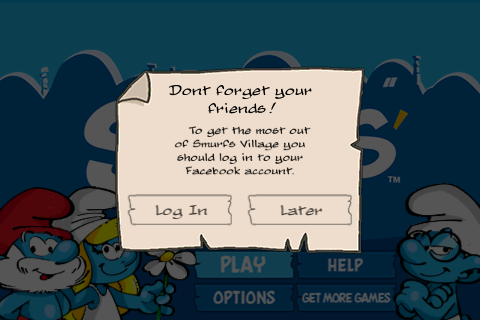
Linking with facebook
After a very short introductory story, explaining why the Smurfs are moving, the game drops you straight into making a new village. With clear directions, the game tells me to click on the sign and lay a plot of land:
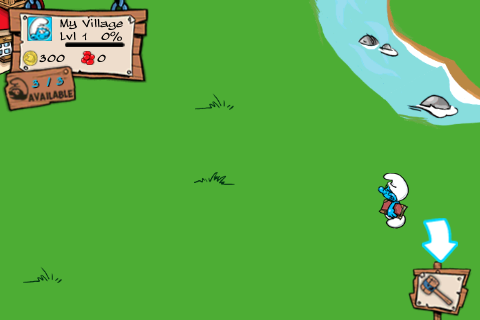
Planting a field
And with that, I get an immediate positive reaction “Quest complete”, and reinforcement of the lesson I just learnt:
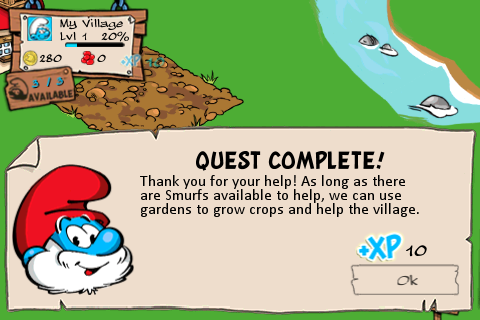
Quest Complete
Now the same happens again with ‘growing blueberrys’, where an arrow clearly indicates what I need to do, and I’m given positive reinforcement having completed this task:
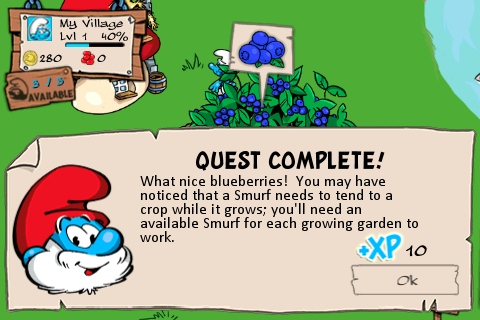
Planting berries...
And with that, a level up is gained:
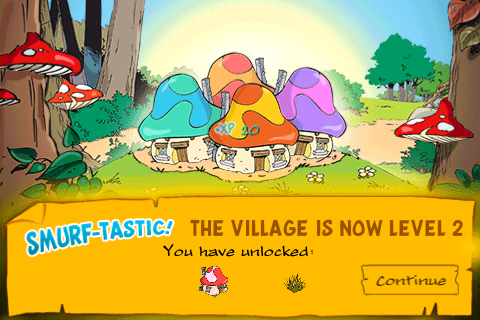
Level up!
The game goes on, with the next level teaching you how to build a house, and crucially linking speeded up progress with using smurfberrys. Since smurfberries are the games in-app-purchase, and hence the primary method the developer makes money, this is an important link to make early on:
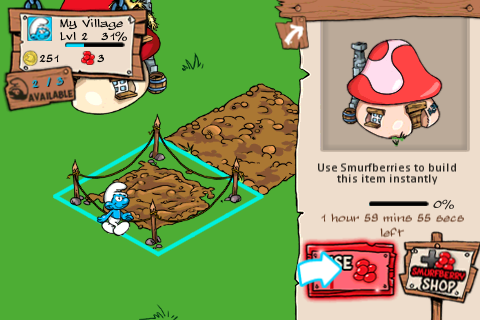
In app purchases
This earns me another level up. The game then goes on to repeat this to teach me how to build grass, before letting me play a mini-game to break up the monotony. If I were to continue playing beyond the first few minutes, the game would go on to ‘set me free’ and let me use the lesson’s I’ve learnt to continue to build the village unguided.
The Rules
So, what magic rules did we find that led to a successful first 5 minutes with this game?
1. Explain actions one at a time, let the player do them
- The game takes care to only show the player one action at a time, and first describes the task, before guiding them through performing the task themselves, to ensure that players know how to do it. The game then confirms the correct action has taken place after it has been completed, and tells the player what they did.
- By repeating the action numerous times, the game hence reinforces to the player how the action is achieved.
2. Reward the player for performing an action correctly
- When an action has been performed, there are multiple layers of success shown. Not only are there visible indications that the task has taken place, and the player is rewarded with both experience points and a ‘quest complete’ dialog, but the game also levels up the player’s village.
- Hence there is positive reinforcement that the correct action has taken place, causing the player to want to perform it again, much like Peggle’s Ode to Joy
3. Show the player the potential of what they can achieve
- By setting the game after the destruction of the original village, and allowing them to build a new one from the ground-up, this game highlights what can be done by the player if they were to continue playing.
- This message would potentially be reinforced by introducing the social element of the game, for it will be possible to see other player’s complete villages.
4. Let them take control
- After the tutorial period (admittedly longer than the 5 minutes I played for today), the game will hand over the reins to the player, having shown them what’s possible, and give the ability to create solutions in a manner of their own choosing.
- Although there will be continued goals to achieve, the method to achieve these goals becomes more free-form after the tutorial allowing the player to introduce creativity into their gameplay.
All these factors have been an important part of the continued success of this social game. Soon I will look at an alternative, unsuccessful, social game, and note what factors lead to its failure.
Hi Steve, I’ve just discovered your blog — already, it looks like the best blog on the web for games UX, in my opinion.
I know this is off-topic, but on another post you give UX games predictions for 2011. It would be nice to see that post revisited at the end of the year, to see what your thoughts at that point are.
In the meantime, I’m off to design the next Farmville 😉